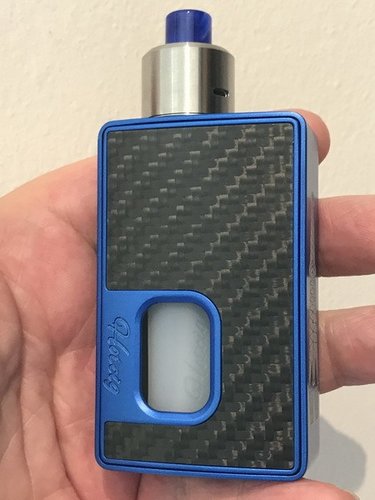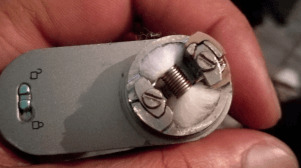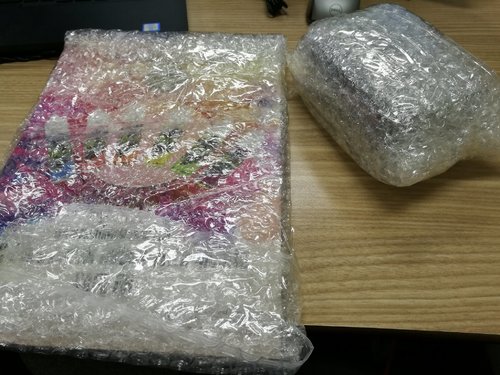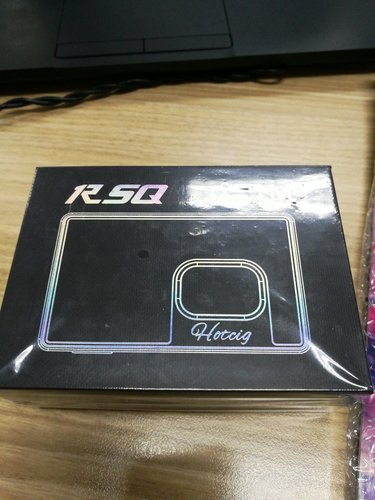Navigation
Install the app
How to install the app on iOS
Follow along with the video below to see how to install our site as a web app on your home screen.

Note: this_feature_currently_requires_accessing_site_using_safari
More options
You are using an out of date browser. It may not display this or other websites correctly.
You should upgrade or use an alternative browser.
You should upgrade or use an alternative browser.
RSQ Hotcig regulated Squonker Reviews
- Thread starter Rob Fisher
- Start date
I have been using the RSQ all weekend and the battery life seems to be great as well as all the other positives this little gem has been getting. I have tried to find fault with it but apart from maybe a little heavy (which is also a positive because it's really well made) I'm really enjoy it. I think there are going to be a lot of happy regulated squonkers when vape mail starts arriving today!
I have been using the RSQ all weekend and the battery life seems to be great as well as all the other positives this little gem has been getting. I have tried to find fault with it but apart from maybe a little heavy (which is also a positive because it's really well made) I'm really enjoy it. I think there are going to be a lot of happy regulated squonkers when vape mail starts arriving today!
I cant wait, Courier guy should be here before 10 looking at my previous deliveries. The excitement is killing me
Mine should arrive tomorrow can’t wait
Sent from my iPhone using Tapatalk Pro
Sent from my iPhone using Tapatalk Pro
How’s the chip compared to the likes of the dna board in the inbox ?
Well it's not a DNA board but it certainly does the job A OK... I still have my HotCig R150 and it's the one mod I'll never sell despite the fact I never use it anymore... we bonded at the time.
https://www.kjmagnetics.com/blog.asp?p=sticky-business-how-to-glue-neodymum-magnetsOne issue found already, one of the door magnets fell off already when opening the door
Sticky Business - How to Glue Neodymium Magnets
About Adhesives and Glue
In so many applications, some form of glue or adhesive is used to hold a magnet in place. With so many questions about glue, we thought we'd share some of the things we've learned over the years of gluing neodymium magnets.
Make Sure the Surfaces are Clean
While we're by no means a bunch of adhesive experts like the folks at 3M or Loctite, we've glued our fair share of magnets in various assemblies, projects, products and test rigs. For specific details, be sure to read the instructions on the exact adhesive you're using. We've found that they all seem to start with something along the lines of, "Clean the surface before applying the glue."
That can't be stressed enough. The surfaces must be clean. It's amazing how a little bit of greasy fingerprints can reduce the strength and repeatability of a glue bond. You can use isopropyl alcohol with a swab or cloth. There are some products sold as adhesive primers, usually made of alcohol or acetone. They are another way of making sure the surface is clean.
Scratch the Surface

D82 magnets, sanded, scratched and stock
Many adhesives have specific instructions for surface preparation of steel or aluminum. While they never seem to have specific recommendations for nickel-plated neodymium magnets, we've followed their recommendations for metals. For example, check out the top of page 4 of this spec for 3M's DP-100 Epoxy Adhesive. For bonding to steel, it says:
- Wipe free of dust with oil-free solvent such as acetone or isopropyl alcohol.
- Sandblast or abrade using clean fine grit abrasives
What Glue Should I Use?
There are a number that usually work quite well. Here's a list of a few of the basics you might choose from:
- Two-Part Epoxy (often sold as 5-minute epoxy in stores) Most epoxies work well, but pay attention to the cure-times.
- Cyanoacrylate (super glue or crazy glue)
- Urethane adhesives (sold as Gorilla Glue)
- JB Weld see updates below
- Liquid Nails
- Mod Podge
- Silicone adhesives
What Not to Use!

Do not use a hot glue gun on neodymium magnets. While this adhesive works really well on so many surfaces, the high temperatures can demagnetize your magnets. Even the so-called low temperature hot melts are well above the Maximum Operating Temperatures of most neodymium magnets. Don't do it!
Gluing Plastics
Trying to adhere magnets to plastics is a sticky issue that quickly gets complicated. Again, we're not adhesive experts, so consider contacting technical support at an adhesive company for your specific needs.
Some plastics are easier than others to glue to. Plastics like ABS (used in many consumer products) and PVC (the white plumbing pipes) work well with many different adhesives. Other plastics like Polypropylene (milk jugs) or Polyethylene (plastic shopping bags) are practically impossible to get a strong bond with. For some, you will have to resort to a mechanical bond.
Other Adhesive Ideas
For smaller magnets, double-sided adhesive tape can be a good fit. Such tapes are generally not strong enough for the really big, powerful magnets. Such options might include 3M's VHB Tape, or our own Adhesive Dots, which are pre-cut for a number of disc sizes.
Updates!
Glue and magnets is such a hot topic, we've received a number of great suggestions from our customers. Thanks to all who have shared their experiences!
One of our customers wrote in about good results with a high peel strength Double/Bubble Orange epoxy adhesive. They have a neat package that's a one-time-use envelope.
Another reported good success holding cylindrical and ring magnets into holes in an anodized aluminum part using Loctite 609 (acrylic adhesive) and Loctite 638 (urethane methacrylate). When used with Loctite 7649 primer (an acetone cleaner), they didn't find it necessary to roughen either surface.
A number of folks wrote in to warn about using JB Weld adhesive with powerful neodymium magnets. JB Weld is a popular epoxy adhesive with steel filler material. Apparently, the flakes of metal help to draw the material all around the entire magnet while the glue is still wet, making an awful mess. While there might be a few applications where this phenomenon is a feature, be cautious for general use. Thanks to everyone who wrote in! Also note that, if controlled, some folks also reported great bond strength using JB Weld.
For gluing to plastics, a customer strongly recommend checking out Loctite Plastic Bonder Epoxy. It's an epoxy formula with acrylic in it. They reported great results with Polycarbonate (PC), without having to roughen either surface! Loctite says it works well with, "ABS, PVC, Acrylic, Nylon, Polycarbonate and Mylar."
Avoid gluing magnets to plastics with 3M thin transfer tape. This is due to the surface flatness of the magnet vs the plastic can cause areas of poor contact so the adhesive doesn’t "wet out."
Don't let the freshly assembled product cure near steel products or other assemblies that might pull the magnet away while the adhesive dries. Instead, try arranging magnets so that they pull towards a steel plate so that it holds the magnet in position!
3M foam tape with Low Surface Energy (LSE) adhesive on both sides works will with magnets and ABS plastic. The foam gives enough to "wet out" both surfaces.
B
BioHAZarD
Guest
Always ready with a helping hand
Sticky Business - How to Glue Neodymium Magnets
About Adhesives and Glue
In so many applications, some form of glue or adhesive is used to hold a magnet in place. With so many questions about glue, we thought we'd share some of the things we've learned over the years of gluing neodymium magnets.
Make Sure the Surfaces are Clean
While we're by no means a bunch of adhesive experts like the folks at 3M or Loctite, we've glued our fair share of magnets in various assemblies, projects, products and test rigs. For specific details, be sure to read the instructions on the exact adhesive you're using. We've found that they all seem to start with something along the lines of, "Clean the surface before applying the glue."
That can't be stressed enough. The surfaces must be clean. It's amazing how a little bit of greasy fingerprints can reduce the strength and repeatability of a glue bond. You can use isopropyl alcohol with a swab or cloth. There are some products sold as adhesive primers, usually made of alcohol or acetone. They are another way of making sure the surface is clean.
Scratch the Surface

D82 magnets, sanded, scratched and stock
Many adhesives have specific instructions for surface preparation of steel or aluminum. While they never seem to have specific recommendations for nickel-plated neodymium magnets, we've followed their recommendations for metals. For example, check out the top of page 4 of this spec for 3M's DP-100 Epoxy Adhesive. For bonding to steel, it says:
All epoxies and many other adhesives call for roughening of an especially smooth surface. Use a light grit sandpaper to lightly sand a little bit of the nickel plated surface prior to gluing. After sanding, be sure to clean the dust off the magnet first! For some sizes, you can even just scratch the surface a little with a sharp nail, which works almost as well.
- Wipe free of dust with oil-free solvent such as acetone or isopropyl alcohol.
- Sandblast or abrade using clean fine grit abrasives
What Glue Should I Use?
There are a number that usually work quite well. Here's a list of a few of the basics you might choose from:
In a majority of applications we see, epoxy works best. It's generally good at bonding with both the nickel plating of our magnets and many other surfaces.
- Two-Part Epoxy (often sold as 5-minute epoxy in stores) Most epoxies work well, but pay attention to the cure-times.
- Cyanoacrylate (super glue or crazy glue)
- Urethane adhesives (sold as Gorilla Glue)
- JB Weld see updates below
- Liquid Nails
- Mod Podge
- Silicone adhesives
What Not to Use!

Do not use a hot glue gun on neodymium magnets. While this adhesive works really well on so many surfaces, the high temperatures can demagnetize your magnets. Even the so-called low temperature hot melts are well above the Maximum Operating Temperatures of most neodymium magnets. Don't do it!
Gluing Plastics
Trying to adhere magnets to plastics is a sticky issue that quickly gets complicated. Again, we're not adhesive experts, so consider contacting technical support at an adhesive company for your specific needs.
Some plastics are easier than others to glue to. Plastics like ABS (used in many consumer products) and PVC (the white plumbing pipes) work well with many different adhesives. Other plastics like Polypropylene (milk jugs) or Polyethylene (plastic shopping bags) are practically impossible to get a strong bond with. For some, you will have to resort to a mechanical bond.
Other Adhesive Ideas
For smaller magnets, double-sided adhesive tape can be a good fit. Such tapes are generally not strong enough for the really big, powerful magnets. Such options might include 3M's VHB Tape, or our own Adhesive Dots, which are pre-cut for a number of disc sizes.
Updates!
Glue and magnets is such a hot topic, we've received a number of great suggestions from our customers. Thanks to all who have shared their experiences!
One of our customers wrote in about good results with a high peel strength Double/Bubble Orange epoxy adhesive. They have a neat package that's a one-time-use envelope.
Another reported good success holding cylindrical and ring magnets into holes in an anodized aluminum part using Loctite 609 (acrylic adhesive) and Loctite 638 (urethane methacrylate). When used with Loctite 7649 primer (an acetone cleaner), they didn't find it necessary to roughen either surface.
A number of folks wrote in to warn about using JB Weld adhesive with powerful neodymium magnets. JB Weld is a popular epoxy adhesive with steel filler material. Apparently, the flakes of metal help to draw the material all around the entire magnet while the glue is still wet, making an awful mess. While there might be a few applications where this phenomenon is a feature, be cautious for general use. Thanks to everyone who wrote in! Also note that, if controlled, some folks also reported great bond strength using JB Weld.
For gluing to plastics, a customer strongly recommend checking out Loctite Plastic Bonder Epoxy. It's an epoxy formula with acrylic in it. They reported great results with Polycarbonate (PC), without having to roughen either surface! Loctite says it works well with, "ABS, PVC, Acrylic, Nylon, Polycarbonate and Mylar."
Avoid gluing magnets to plastics with 3M thin transfer tape. This is due to the surface flatness of the magnet vs the plastic can cause areas of poor contact so the adhesive doesn’t "wet out."
Don't let the freshly assembled product cure near steel products or other assemblies that might pull the magnet away while the adhesive dries. Instead, try arranging magnets so that they pull towards a steel plate so that it holds the magnet in position!
3M foam tape with Low Surface Energy (LSE) adhesive on both sides works will with magnets and ABS plastic. The foam gives enough to "wet out" both surfaces.
Nice one @Alex
@Rob Fisher does anyone hav any play on their door? Any movement back and forth that’s my pet hate very keen to know
@Rob Fisher does anyone hav any play on their door? Any movement back and forth that’s my pet hate very keen to know
I feel you with the door play... there is a little bit of play... but that I can live with because to feel the play you really need to try get the movement. But with normal use there is no play to drive you crazy.
Those of you who have the RSQ and those about to get it - pleeeeeeez fill this thread with you experiences and views.
I am on the edge with this as my first regulated squonker so will count on your opinions and experiences to make a decision.
I am on the edge with this as my first regulated squonker so will count on your opinions and experiences to make a decision.
Those of you who have the RSQ and those about to get it - pleeeeeeez fill this thread with you experiences and views.
I am on the edge with this as my first regulated squonker so will count on your opinions and experiences to make a decision.
One word, brilliant.
Really small for a regulated squonk, as per @Rob Fisher , it is a bit hefty.
Solid construction even though my magnet fell off. I have mended it.
Super soft squonk bottle and the HM chip isn't too bad as well
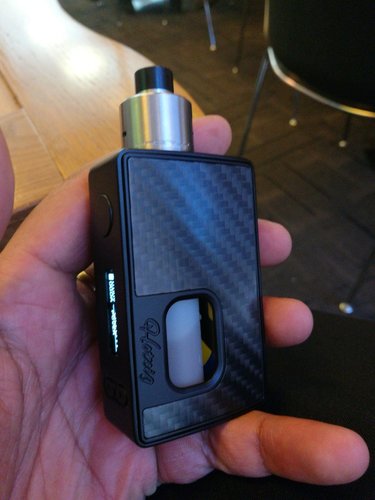
B
BioHAZarD
Guest
Got mine
very very nice
only downside is the magnet that was not stuck on.
shitty quality control unfortunately but I am sure the rest of the mod will work fine.
very very nice
only downside is the magnet that was not stuck on.
shitty quality control unfortunately but I am sure the rest of the mod will work fine.
B
BioHAZarD
Guest
soooo
quick take on the mod
more comfortable in the hand than the SVA clone (rounded shape to the RSQ)
screen not as nice as that of the DNA
size is perfect
quite a bit heavier than the SVA but in a nice solid way
self adjusting 510 is a clear win
magnets are crap but can be fixed
provided squonk bottles are crap - swopped in my arctic dolphins fits perfectly
fits perfectly
so all in all quite a win for the price
entheon has found a new home
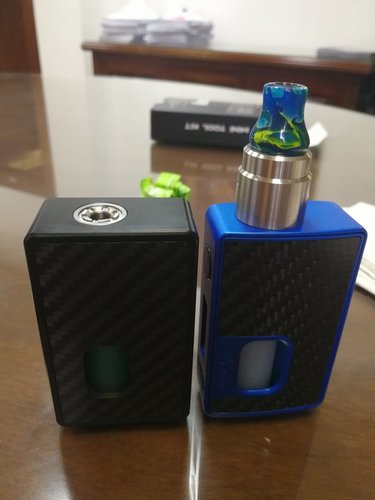
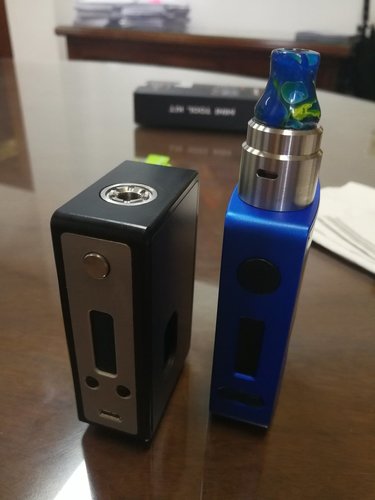
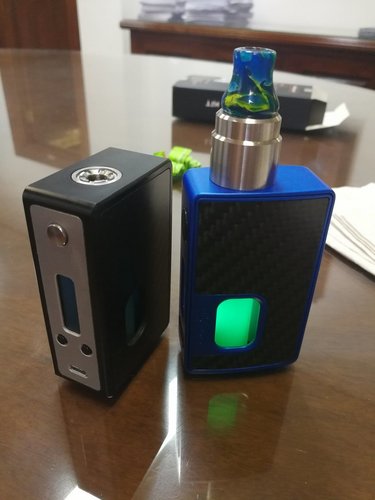
quick take on the mod
more comfortable in the hand than the SVA clone (rounded shape to the RSQ)
screen not as nice as that of the DNA
size is perfect
quite a bit heavier than the SVA but in a nice solid way
self adjusting 510 is a clear win
magnets are crap but can be fixed
provided squonk bottles are crap - swopped in my arctic dolphins
so all in all quite a win for the price
entheon has found a new home



Last edited by a moderator:
soooo
quick take on the mod
more comfortable in the hand than the SVA clone (rounded shape to the RSQ)
screen not as nice as that of the DNA
size is perfect
quite a bit heavier than the SVA but in a nice solid way
magnets are crap but can be fixed
provided squonk bottles are crap - swopped in my arctic dolphinsfits perfectly
so all in all quite a win for the price
entheon has found a new home
View attachment 113797 View attachment 113798 View attachment 113799
I was looking for a comparison to the SVA clone, Thanks
Well it's not a DNA board but it certainly does the job A OK... I still have my HotCig R150 and it's the one mod I'll never sell despite the fact I never use it anymore... we bonded at the time.
Collecting my R150 when I come to SA later this month.
Sent by iDad's iPhone
So I’m about to pop into Sirs later on to get this squonker but my question is what RDA do i get, I’m after flavour over clouds if that helps, any help guys?
Flave , Soul S , Hadaly depending on your vaping style you can't go wrong with either. Good luck getting an auth one so I'd suggest see what clones Sirs have in stock. The WASP Nano also comes to mind great little atty for the price .....
HM tools found here to setup and modify RSQ http://www.hot-vapor.com/download.asp?id=143&i=143
Change themes, wire, default screen config, shutoff time......alles
You Welcome fellow vapers
Change themes, wire, default screen config, shutoff time......alles
You Welcome fellow vapers
Similar threads
- Replies
- 3
- Views
- 126
- Replies
- 0
- Views
- 589
- Replies
- 0
- Views
- 2K
- Replies
- 0
- Views
- 93


